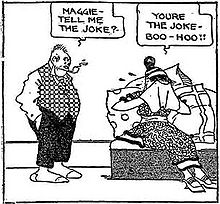Bringing Up Father

Bringing Up Father is the best known comic by the American cartoonist George McManus . The daily strip distributed by the King Features Syndicate was continued after McManus' death by several cartoonists and authors and appeared from 1913 to 2000. During this time it was made into films several times.
Plot and style
Influenced by the 1890s musical The Rising Generation by William Gill, the comic strip is about the Irish brickworker Jiggs, who became a millionaire after winning the lottery, and his wife Maggie, who works in a laundry. While Jiggs wants to keep the habits of his old lifestyle, Maggie tries to lead the life of a new rich . The family includes the daughter Nora, who, in contrast to her caricatured parents, has finely drawn facial features.
In addition to caricaturing the two main actors, McManus in particular used the individual panels to let his characters change the plane of the drawing.
Publication and draftsman
The first strip of the comic strip drawn by George McManus and distributed by the King Features Syndicate was released on January 12, 1913. The first Sunday page followed on April 14, 1918. McManus drew the strip until his death. Vernon Greene then took over the strip and continued it until his own death in 1965. The Sunday pages were taken over by Frank Fletcher , who drew Bringing Up Father from 1955 to 1984 to texts by Bill Kavanagh . Hal Campagna drew the strip from 1965 to 1980, also to texts by Bill Kavanagh . Frank B. Johnson took over Bringing Up Father in 1981 and continued it until he was retired in 2000.
The Strip was published in up to 750 newspapers in the United States alone. According to McManus two years before his death earned him the comic book, which was translated to McManus' lifetime in 27 languages, twelve million dollars a. In Germany, Bringing Up Father was published temporarily under the title Herr Schmerbauch . Entitled family idiot appeared Bringing Up Father in the Sunday supplements of the Morning Journal's , a German-language edition of the New York Journal , which is published by Hearst from 1890 to 1918.
Bringing Up Father has been filmed several times as a real or animated film. As early as 1915 there was a first film with the same title. McManus took on the role of Jiggs in several real-life films. In addition, a comedy was created based on the comic, which was performed simultaneously by at least seven stage companies.
reception
According to Andreas C. Knigge , "McManus' superior, safe play with elegant lines and surfaces, inspiring graphic ideas and good gags make [...] Bringing Up Father one of the best newspaper series of the first half of the century".
literature
- Marcel Feige : The little comic dictionary . Schwarzkopf and Schwarzkopf, Berlin 2005, ISBN 3-89602-544-9 , pp. 116–117.
- Franco Fossati: The large illustrated Ehapa comic lexicon . Ehapa Verlag, Stuttgart 1993, ISBN 3-7704-0865-9 , p. 39.
- Andreas C. Knigge : Comic lexicon . Ullstein Verlag, Frankfurt am Main; Berlin 1988, ISBN 3-548-36554-X , pp. 321-322.
- Andreas C. Knigge: Comics . Rowohlt Taschenbuch Verlag, Reinbek 1996, ISBN 3-499-16519-8 , pp. 44-46.
Individual evidence
- ↑ a b Marcel Feige: The little comic dictionary . Schwarzkopf and Schwarzkopf, Berlin 2005, ISBN 3-89602-544-9 , p. 117.
- ↑ Gli Annali del Fumetto 1895–1913 on lfb.it (Italian) , accessed on January 27, 2012
- ↑ a b Andreas C. Knigge: Comics . Rowohlt Taschenbuch Verlag, Reinbek 1996, ISBN 3-499-16519-8 , p. 45
- ↑ Vernon Greene on lambiek.net (English) , accessed on January 27, 2012
- ↑ Frank Fletcher on lambiek.net (English) , accessed on January 27, 2012
- ↑ Hal Campagna on lambiek.net (English) , accessed on January 27, 2012
- ↑ Frank B. Johnson on lambiek.net (English) , accessed January 27, 2012
- ↑ a b c "Jiggs' Creator, McManus, Dies", The Milwaukee Sentinel , October 22, 1954.
- ^ A b Franco Fossati: The large illustrated Ehapa comic lexicon . Ehapa Verlag, Stuttgart 1993, ISBN 3-7704-0865-9 , p. 39.
- ↑ Andreas C. Knigge: ZEICHEN-WELTEN , accessed on December 5, 2012
- ↑ Bringing Up Father in the Internet Movie Database , accessed January 27, 2012
- ↑ George McManus in the Internet Movie Database , accessed January 27, 2012
